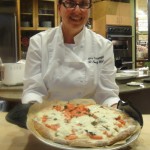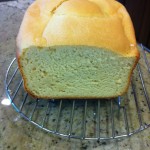If you don’t know my story, I’ll try telling it briefly. If you know me, you probably know that being brief is difficult for me. In 2007, when my daughter was diagnosed with what we thought was a gluten sensitivity for her eczema, I didn’t think I had to be 100% strict. There was a lot I didn’t know.
In 2009, when I went gluten-free, it never occurred to me to be tested for celiac disease. This is a decision I now regret but I didn’t know what I know now. A year later, my son was tested for celiac disease and a gluten sensitivity. Because his celiac test came back negative and I thought he only had a sensitivity, I didn’t think I’d have to be strict. Since then, a lot has changed.
I have learned since then that my husband and I both carry genes for celiac disease. I have learned that you don’t have to have severe symptoms to have celiac disease; there can be other indicators that people often ignore. I have learned you can have no symptoms. I have learned during this time that I should have been strict from the beginning.
Why tell you this before you get started? I don’t want you to make the same mistakes. Also, if you aren’t strict and you are trying gluten-free to see if it alleviates a symptom, there’s no way to know unless there is no gluten in your diet. I do believe that not everyone has to have celiac disease to benefit from a gluten-free diet. I have met many people who have tested negative multiple times but know that gluten-free is the right choice. What I’m highly suggesting is that you “go in it to win it”, a phrase I coined after a class one night. Another reason is that if you are intolerant to gluten, it can be doing damage you don’t see or feel. Have I convinced you yet? Well, here are 10 tips for starting a gluten-free diet:
**Please, please, before you start. Get tested for celiac disease first! You can get more information here on which tests to ask for or read this interview with The Gluten-Free RN.
1. Be in it to win it. Yes, I already said it but don’t plan to cheat. If you have celiac disease, you won’t have this choice.
2. Plan to make mistakes in the beginning. I mean this more from a mental standpoint. It’s very easy to miss things and you will get mad at yourself. You have to be able to forgive yourself.
3. Make a meal plan before you shop and start. This is really your strategy. You can approach this part in two ways. You can try to find the replacements for everything you eat (which you probably have heard is not the healthiest if you start eating sugar-laden gluten-free processed foods) or you might take it as a chance to change what you are eating. For me, eventually, I ate less sandwiches at lunch and more salads. We stopped eating bread at dinner and having pasta 3 times a week. This might take a while.
4. Make your shopping list. You will need to replace obvious things like bread, pasta, cereals, and crackers. Don’t forget about soy sauce, certain rice cereals, spices, salad dressings, and oats (yes, you need to use/buy gluten-free oats). You can download a gluten-free pantry list from my website here (scroll down to download the form). The National Foundation for Celiac Awareness (NFCA) also has a good guide here.
5. Start cleaning. Living gluten-free means your kitchen has to be as well. Plan to clean out drawers, counters, etc. to remove any chance of cross contamination. You might even need a new toaster unless you use toaster bags or foil to toast (if you have a toaster oven).
** I do receive a small percentage of the sale from Amazon.com if you purchase from these links (it does not increase your cost). I’m talking small, folks. **
6. Clean your make-up. Yes, gluten can be in your lipstick, soap, shampoo, etc. At a minimum, if this seems overwhelming, start with anything that can be ingested like lipstick).
7. Get ready to cook. It’s going to be expensive and potentially disappointing if you buy everything from pizza, cookies, muffins, and pie. All of these can be made in your own kitchen. I suppose that’s one reason I wrote The Warm Kitchen (shameless plug, yes). But seriously, it is. I much prefer my own food to almost anything I can buy. As Living Without Magazine said in their review of the book, “How do you make a white sauce? What’s the secret to a flaky gluten-free pie crust? Trained chef Amy Fothergill details this information and much more…” Read the full review here.
8. Meal plan for parties and events. Don’t leave yourself in the situation where you arrive someplace and then realize there’s nothing you can eat. I went to a party recently and ate just a little before going so I wouldn’t be too hungry, assuming (doh!) there would be something I could eat. Every single dish had some type of gluten in it. I snacked on fruit, nuts, and some cheese (out of desperation). It’s probably a good idea to keep a protein bar handy. Think about what you can bring to a party or event. Check with the hostess and don’t be embarrassed. This is serious stuff.
9. Be ready to feel deprived. Gluten-free sounds good on paper to some folks but when the rubber hits the road and you really have to say no to that delicious looking meatball, almost all food at a fair or event, Aunt Mary’s pie, NY pizza…well, you might just be a little bummed out. I’m not telling you this to depress you; I’m sharing how I have felt. My daughter said to me one day “Mama, I wish everyone was gluten-free. Then we wouldn’t have to worry about what we eat.” Out of the mouths of babes. You have to be strong, especially if you have celiac disease or an intolerance.
10. Check and recheck. My mom had a lot of sayings; “many hands make light work”, “too many cooks spoil the broth”, and yes, “check and recheck”. When it comes to gluten-free dining and products, I can’t reiterate this enough. My daughter is a real detective. She has questioned products like Korean hot sauce, veggie sticks, and marinated chicken. She has a sixth sense in a way. I have found that many restaurants assume they know gluten-free but may not. Many do not know that imitation crab (which you often find in California rolls) is made with wheat. Check and recheck.
I hope this list is helpful. It’s certainly not everything but it’s a good start. For other websites and resources on gluten-free, check out some of my friends like Gluten-Free RN, A Girl Defloured, Celiac and the Beast, Zest Bakery, Art of Gluten-Free Baking, I’m a Celiac, Vegetarian Mamma, Raising Jack with Celiac, and My Gluten-Free Kitchen. Or search this blog for recipes; there’s plenty here.
Do you have any other tips that have helped you? My readers would love to hear them!







Great article and thank you for the shout out! 🙂 xo
Chef Amys mission is awesome. Ive done this type of cooking under chefs and cooks that understood the dynamics of gluten free, i do believe educating yourself is key. Read current news, take cooking classes from experts, and talk to celiac patients. Shop glutenfree and learn what foods are safe to use…good luck. Thank you Chef Amy its nice to know my colleagues care about this.
Ron
It would definitely all be much easier if everyone were gluten-free! And, for those who have allergies, nut-free, dairy-free, egg-free, et cetera-free, and meatless for vegetarians like me…but at a certain point that’d leave us all drinking Soylent, which I’d prefer NOT to see happen. 😀 In the meantime, I agree, it’s best to cook at home and seek out GF-friendly restaurants occasionally. Thanks for the great list.
Thank you for sharing some really insightful tips! Starting a gluten-free diet can be difficult, but this will definitely help those who have been recently diagnosed. It’s all about empowering yourself by learning how to cook gluten-free and doing your research!
– DDS (https://byeegluten.wordpress.com/)